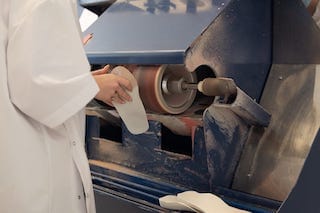
The therapeutic soles are made in our own laboratory, where a unique sole is made for each patient.
The podiatrist / register podologist has conducted an examination, which shows that your feet need a therapeutic sole to function better.
This is a flexible, custom-made insole to maintain the position of your feet, to correct, to relieve parts of your foot or to reduce pain. The sole also provides more stability while walking.
The soles are made in our own laboratory, where a unique sole is produced for each patient using 3D printing or 3D milling techniques based on the 3D scan made during the examination.
When making the sports soles, we choose materials that provide more cushioning during sports, and a covering material is used that is more resistant to perspiration.
To promote the wearing of the insoles by children, we have a wide range of colored cover materials.
Give yourself and your feet time to get used to the new foot position.
If you are going to wear therapeutic soles for the first time, we recommend that you gradually build up the habituation process and start with a few hours a day. You then build this up to full use in two weeks.
If the soles still cause pressure points after this period, please contact the secretariat within six weeks to make a follow-up appointment. A small adjustment is sometimes necessary to remedy the problem.
Ensure the sole of the shoe is as flat as possible and remove all bumps and any comfort insoles.
Just as there are regular and sports shoes, there are also regular and sports soles. An attempt will be made to achieve the widest possible use of the soles, but the podiatrist may also recommend sports soles in addition to regular soles.
Remove the soles from your shoes every evening to allow them to dry properly; this significantly extends their lifespan. If the soles become wet due to perspiration or rain, never dry them on the heater or other heat source.
If you suffer from excessively sweaty feet, it is definitely worth considering purchasing a second pair. If you change them every day, the soles will have plenty of time to dry before you wear them again. You can grease soles with a leather cover once every three months with colorless shoe or leather grease. You can wipe soles with a plastic cover with a damp cloth.
The expected lifespan of the soles depends largely on the care of the soles, whether you have dry or 'wet' feet, whether you walk a lot or not, whether you wear them all day, etc.
On average, you can count on one and a half to two years. An annual sole check is recommended. In case of changes or growth in children, we ask you to contact us earlier.
Preferably buy your shoes around noon, your feet can swell during the day. Make sure the shoes are longer than your loaded feet. If you have a small size difference in your feet, buy the shoes on the longest foot. Shoes do not grow, they only become more flexible in use. The shoes must have the correct width size, the heel must fit in the counter and the forefoot must not be pinched. The model of the shoe must match the shape of the foot. The toes should be able to lie freely and straight next to each other in the shoe without being pushed out of their natural position. Always try on both shoes, also walk with them in the store. Do not buy if in doubt.
The outsole of the shoe may be made of different materials, provided the shoes remain flexible. Leather is recommended for the upper of the shoe in connection with the comfort and perspiration of the feet.
The wider the heel of the shoe, the more stable you stand on the shoe. A firmer counter (around the heel) gives less chance of spraining the ankle. The heel should not be higher than 3 cm.

